Calculation of the Risk of Lawsuits over Construction Flaws in Flat Roofs
Abstract
1. Introduction
- Firstly, to outline those construction flaws which are most common in flat roofs, based on lawsuits filed by owners in Spain, as well as indicate their types of pathology origins, classified by different building typologies;
- Secondly, to develop a tool for the determination of probability and risk of lawsuits based on the creation of a weighted risk matrix and the establishment of categories according to the ‘risk factor’;
- Thirdly, to determine the percentage of distribution of the construction flaws analyzed and their greater or lesser presence in population centers, according to the number of inhabitants and the gross domestic product per capita.
2. Methodology
2.1. Origin of the Data, Scope and Procedure
2.2. First Phase of the Research
- -
- Descriptor 1: ‘Construction flaws’. According to the lawsuits filed by the owners, they correspond to: ‘Condensations’ (CF1), ‘Fissures’ (CF2), ‘Humidity’ (CF3) and ‘Infiltrations’ (CF4).
- -
- Descriptor 2: ‘Pathology origin’ of the construction flaws. Categorized into two types:
- -
- ‘Properties and characteristics of materials’ (PCM): those related to the material itself, its format or intrinsic characteristics;
- -
- ‘Conditions of placement and application’ (CPA): those related to the prescriptions or omissions of the design, or to the indications and decisions made during the execution stage.
- -
- Descriptor 3: ‘Building typology’. The buildings studied were classified into: ‘Apartment blocks’ (T-A), ‘Detached houses’ (T-B), ‘Semi-detached houses’ (T-C).
2.3. Second Phase of the Research
- Stage 1—Scoring by the degree of the problem represented by the type of construction flaw (CFx; first descriptor) and its pathology origin (CPA or PCM; second descriptor).
- Stage 2—Level of joint severity, defined as the numerical combination of the scores defined in Stage 1. The second part of table of Section 3.4 (Determination of Categories of Lawsuit Risk) shows the results, obtained by multiplying each type of pathology origin by each type of construction flaw.
- Stage 3—Each of the 24 possible combinations, resulting from the interrelation of the 4 types of construction flaws, the 2 types of pathology origins, and the 3 types of building typologies, was quantified. According to each interrelation’s level of presence, an ‘interrelation and intensity matrix’ was defined, from which are obtained the percentage values of table of Section 3.2 (the results are shown in the third part of table of Section 3.4 (Determination of Categories of Lawsuit Risk)).
- Stage 4—A weighted risk matrix is created for lawsuits, resulting from multiplying the level of joint severity (determined in Stage 2) by the ‘interrelation and intensity matrix’ (determined in Stage 3). Each value of that matrix is named ‘risk factor’ (F). The results are expressed in the fourth part of table of Section 3.4 (Determination of Categories of Lawsuit Risk) and show how extensive and intense the cases found in this research can be. In this way, F numerically quantifies the possibility that an owner files a lawsuit about a construction flaw, according to the specific problem in question.
- Stage 5—Five risk categories for lawsuits by owners are created, according to the values obtained by F in the previous stage, as there is a wide range of results, in which the largest value is 864.5 times greater than the smallest value. With this categorization, the visualization and understanding of the results is facilitated.
2.4. Third Phase of the Research
3. Results
3.1. Cases by Type of Construction Flaw
3.2. Cases by Building Typology
3.3. Cases by Pathology Origin
3.4. Determination of Categories of Lawsuit Risk
- -
- Humidity in apartment blocks, caused by conditions of placement and application (CF3/T-A/CPA = 374);
- -
- Infiltrations in detached houses, caused by conditions of placement and application (CF4/T-B/CPA = 238);
- -
- Infiltrations in semi-detached houses, caused by conditions of placement and application (CF4/T-C/CPA = 173.6);
3.5. Analysis by Demographic Aspects
4. Discussion
5. Conclusions
Author Contributions
Funding
Acknowledgments
Conflicts of Interest
References
- Carretero-Ayuso, M.J.; García-Sanz-Calcedo, J. Comparison between building roof construction systems based on the LCA. Rev. De La Construcción J. Constr. 2018, 17, 123–136. [Google Scholar] [CrossRef]
- Gómez-González, A.; Chanampa, M.; Morgado, I.; Acha, C.; Bedoya, C.; Neila, J. Phytodepuration flat roofs: Proposal of grey water management. Inf. De La Construcción 2011, 63, 61–71. [Google Scholar] [CrossRef]
- Guzmán-Sánchez, S.; Jato-Espino, D.; Lombillo, I.; Diaz-Sarachaga, J.M. Assessment of the contributions of different flat roof types to achieving sustainable development. Build. Environ. 2018, 141, 182–192. [Google Scholar] [CrossRef]
- Shin, E.; Kim, H. Benefit–cost analysis of green roof initiative projects: The case of Jung-gu, Seoul. Sustainability 2019, 11, 3319. [Google Scholar] [CrossRef]
- Gómez Sánchez, M.I. Las estructuras de madera en los tratados de arquitectura (1500–1810); Asociación de Investigación Técnica de Industrias de la Madera (AITIM): Madrid, Spain, 2006. [Google Scholar]
- Morgado, J.; Morgado, J.; Flores-Colen, I.; Flores-Colen, I.; de Brito, J.; de Brito, J.; Silva, A. Maintenance programmes for flat roofs in existing buildings. Prop. Manag. 2017, 35, 339–362. [Google Scholar] [CrossRef]
- Garabito López, J.; Rodríguez Sáiz, Á.; Junco Petrement, C.; Garabito López, J.C. Intervention in historical timber roofs: Restore or rebuild? An. De Edif. 2015, 1, 16–22. [Google Scholar]
- Alba Cruz, R.C.; Cruz Álvarez, J.J.; Posada, A.A. Process improvement in quality control for the design of waterproofing systems in buildings. Rev. De Arquit. E Ing. 2013, 7, 1–57. [Google Scholar]
- Garcez, N.; Lopes, N.; de Brito, J.; Sá, G.; Silvestre, J.D. Influence of design on the service life of pitched roofs’ cladding. J. Perform. Constr. Facil. 2015, 29, 04014073. [Google Scholar] [CrossRef]
- Conceição, J.; Poça, B.; de Brito, J.; Flores-Colen, I.; Castelo, A. Inspection, diagnosis, and rehabilitation system for flat roofs. J. Perform. Constr. Facil. 2017, 31, 04017100. [Google Scholar] [CrossRef]
- Roels, S.; Langmans, J. Highly insulated pitched roofs resilient to air flow patterns: Guidelines based on a literature review. Energy Build. 2016, 120, 10–18. [Google Scholar] [CrossRef]
- Ilozor, B.D.; Okoroh, M.I.; Egbu, C.E. Understanding residential house defects in Australia from the State of Victoria. Build. Environ. 2004, 39, 327–337. [Google Scholar] [CrossRef]
- Pahud, D.; Bernasconi, A.; Cadoni, E.; Chianese, D.; Kaehr, P.; Salvadori, D. Durability of flat roofs: practical experience on service life and consequences on the maintenance strategy. In Proceedings of the 10DBMC International Conférence On Durability of Building Materials and Components, Lyon, France, 17–20 April 2005. p. TT6-235. [Google Scholar]
- Morcous, G.; Rivard, H. Computer assistance in managing the maintenance of low-slope roofs. J. Comput. Civ. Eng. 2003, 17, 230–242. [Google Scholar] [CrossRef]
- Sarman, A.M.; Nawi, M.N.; Che-Ani, A.I.; Mazlan, E.M. Concrete flat roof defects in equatorial climates. Int. J. Appl. Eng. Res. 2015, 10, 7319–7324. [Google Scholar]
- Conceição, J.; Poça, B.; de Brito, J.; Flores-Colen, I.; Castelo, A. Data analysis of inspection, diagnosis, and rehabilitation of flat roofs. J. Perform. Constr. Facil. 2019, 33, 04018100. [Google Scholar] [CrossRef]
- Misar, I.; Novotný, M. Defects and behaviour of inverted flat roof from the point of building physics. EDP Sci. 2017, 93, 02002. [Google Scholar] [CrossRef]
- Gonçalves, M.; Lopes, J.G.; De Brito, J.; Lopes, G.A. Mechanical performance of lap joints of flat roof waterproofing membranes. Exp. Tech. 2008, 32, 50–57. [Google Scholar] [CrossRef]
- Lopes, J.G.; Correia, J.R.; Machado, M.X.B. Dimensional stability of waterproofing bituminous sheets used in low slope roofs. Constr. Build. Mater. 2011, 25, 3229–3235. [Google Scholar] [CrossRef]
- Machado, M.X.B. Experimental Study on the Dimensional Stability of Waterproofing Bituminous Membranes Used in Flat Roofs; Instituto Superior Técnico, Universidade Técnica de Lisboa (Portugal): Lisboa, Portugal, 2009. [Google Scholar]
- Silva, R.R.; Lopes, J.G.; Correia, J.R. The effect of wind suction on flat roofs: An experimental and analytical study of mechanically fastened waterproofing systems. Constr. Build. Mater. 2010, 24, 105–112. [Google Scholar] [CrossRef]
- Gonçalves, M.; Lopes, J.G.; de Brito, J. Mechanical performance of lap joints of flat roof waterproofing membranes subjected to artificial weathering. Exp. Tech. 2011, 35, 21–28. [Google Scholar] [CrossRef]
- Piskoty, G.; Wullschleger, L.; Loser, R.; Herwig, A.; Tuchschmid, M.; Terrasi, G. Failure analysis of a collapsed flat gymnasium roof. Eng. Fail. Anal. 2013, 35, 104–113. [Google Scholar] [CrossRef]
- Van den Bossche, N.; Lacasse, M.; Janssens, A. A uniform methodology to establish test parameters for watertightness testing. Part II: Pareto front analysis on co-occurring rain and wind. Build. Environ. 2013, 63, 157–167. [Google Scholar] [CrossRef]
- Van den Bossche, N.; Lacasse, M.; Janssens, A. A uniform methodology to establish test parameters for watertightness testing. Part I: A critical review. Build. Environ. 2013, 63, 145–156. [Google Scholar] [CrossRef]
- Liu, W.; Feng, Q.; Chen, W.; Wei, W.; Deo, R.C. The influence of structural factors on stormwater runoff retention of extensive green roofs: new evidence from scale-based models and real experiments. J. Hydrol. 2019, 569, 230–238. [Google Scholar] [CrossRef]
- Ramasubramanian, P.; Starry, O.; Rosenstiel, T.; Gall, E.T. Pilot study on the impact of green roofs on ozone levels near building ventilation air supply. Build. Environ. 2019, 151, 43–53. [Google Scholar] [CrossRef]
- Marques, J.A.; Lopes, J.G.; Correia, J.R. Durability of the adhesion between bituminous coatings and self-protection mineral granules of waterproofing membranes. Constr. Build. Mater. 2011, 25, 138–144. [Google Scholar] [CrossRef]
- Plachý, J.; Vysoká, J.; Vejmelka, R. Insufficient dimensional stability of bitumen sheets as a source of flat roof defects. MATEC Web Conf. 2017, 93, 02014. [Google Scholar] [CrossRef][Green Version]
- Delgado, A.; Mukhopadhyaya, P.; Normandin, N.; Paroli, R. Characteristics of membranes and insulations used for low-slope roofs. In Anonymous Roofing: Staying on Top of Technology and Change; Institute for Research in Construction, National Research Council Canada: Ottawa, ON, Canada, 2005; pp. 1–15. [Google Scholar]
- Feiteira, J.; Lopes, J.G.; de Brito, J. Mechanical performance of liquid-applied roof waterproofing systems. J. Perform. Constr. Facil. 2011, 27, 244–251. [Google Scholar] [CrossRef]
- Araújo, K.; Boucher, J.L.; Aphale, O. A clean energy assessment of early adopters in electric vehicle and solar photovoltaic technology: Geospatial, political and socio-demographic trends in New York. J. Clean. Prod. 2019, 216, 99–116. [Google Scholar] [CrossRef]
- Wang, L.; Abdel-Aty, M.; Lee, J.; Shi, Q. Analysis of real-time crash risk for expressway ramps using traffic, geometric, trip generation, and socio-demographic predictors. Accid. Anal. Prev. 2019, 122, 378–384. [Google Scholar] [CrossRef] [PubMed]
- Miranda, F.; Rubio, S.; Chamorro, A.; Bañegil, T. Manual de Dirección de Operaciones; Ediciones Paraninfo, SA: Madrid, Spain, 2008. [Google Scholar]
- Marrugo, G.; Valdés, C.F.; Gómez, C.; Chejne, F. Pelletizing of Colombian agro-industrial biomasses with crude glycerol. Renew. Energy 2019, 134, 558–568. [Google Scholar] [CrossRef]
- Rodríguez-Jiménez, C.; Macías-Bernal, J.; Lucas-Ruiz, R. Management model for efficient quality control in new buildings. Inf. De La Construcción 2017, 69, 204–214. [Google Scholar] [CrossRef]
- Carretero-Ayuso, M.J.; Brito, J.D. Multiparameter evaluation of the deficiencies in tiled pitched roofs. J. Perform. Constr. Facil. 2016, 31, 04016097-1–04016097-10. [Google Scholar] [CrossRef]
- MUSAAT. Expert Records and Reports if Accidents; Mútua de Aparejadores y Arquitectos Técnicos: Madrid, Spain, 2012. [Google Scholar]
- SERJUTECA. Reports and Documents on Accidents Involving Professional Civil Liability of Building Surveyors and Technical Architects; Servicios Jurídicos Técnicos Aseguradores: Madrid, Spain, 2012. [Google Scholar]
- Carretero-Ayuso, M.J.; Moreno-Cansado, A. National Statistical Analysis on Construction Anomalies; MUSAAT Foundation: Madrid, Spain, 2013. [Google Scholar]
- AENOR. Norm UNE 41805–10:2010 IN. Diagnosis of buildings. Part 14; Diagnosis report; AENOR: Madrid, Spain, 2010. [Google Scholar]
- AENOR. Norm UNE 41805–1:2009 IN. Diagnosis of buildings. Part 1; General remarks; AENOR: Madrid, Spain, 2009. [Google Scholar]
- AENOR. Norm UNE-EN-31010:2011. Risk Management. Risk Assessment Techniques; AENOR: Madrid, Spain, 2011. [Google Scholar]
- AENOR. Norm UNE-EN 60812:2008. Analysis Techniques for System Reliability. Procedure for Failure Mode and Effects (FMEA); AENOR: Madrid, Spain, 2008. [Google Scholar]
- INE. Population and Housing Census in Spain by National Statistics Institute. Datos Generales Demográficos ed; Instituto Nacional de Estadística: Madrid, Spain, 2017. [Google Scholar]
- INE. National Income and Gross Domestc Product of Spain by National Statistics Institute. Contabilidad Nacional Anual de España ed; Instituto Nacional de Estadística: Madrid, Spain, 2018. [Google Scholar]
- Carretero-Ayuso, M.J.; García-Sanz-Calcedo, J.; Reyes-Rodriguez, A.M. Qualitative and quantitative analyses on project deficiencies in flat-roof design in Extremadura, Spain. J. Constr. Eng. Manag. 2016, 142, 04016061. [Google Scholar] [CrossRef]
- Andújar-Montoya, M.D.; Marcos-Jorquera, D.; García-Botella, F.M.; Gilart-Iglesias, V. A context-driven model for the flat roofs construction process through sensing systems, internet-of-things and last planner system. Sensors 2017, 17, 1691. [Google Scholar] [CrossRef] [PubMed]
- Ahmad, T.; Thaheem, M.J. Developing a residential building-related social sustainability assessment framework and its implications for BIM. Sustain. Cities Soc. 2017, 28, 1–15. [Google Scholar] [CrossRef]
- Ministerio de Fomento. The Commission for the Implementation of the BIM Methodology has been Formed; Report No. 2015/jul/14; Ministerio de Fomento: Madrid, Spain, 2015. [Google Scholar]
- Prieto, J. Musaat presente en los congresos internacionales sobre BIM. Cercha 2017, 133, 46–47. [Google Scholar]
- Carretero-Ayuso, M.J.; Brito, J.D. Analysis of the execution deficiencies of flat roofs with bituminous membranes. J. Perform. Constr. Facil. 2016, 30, 04016049. [Google Scholar] [CrossRef]
- Rodríguez Martín, D. La mediación en construcción. Cercha 2018, 135, 10–17. [Google Scholar]
- Tu, J.; Liu, L.; Cui, Y. A study on consumers’ preferences for the palace museum’s cultural and creative products from the perspective of Cultural SUSTAINABILITY. Sustainability 2019, 11, 3502. [Google Scholar] [CrossRef]
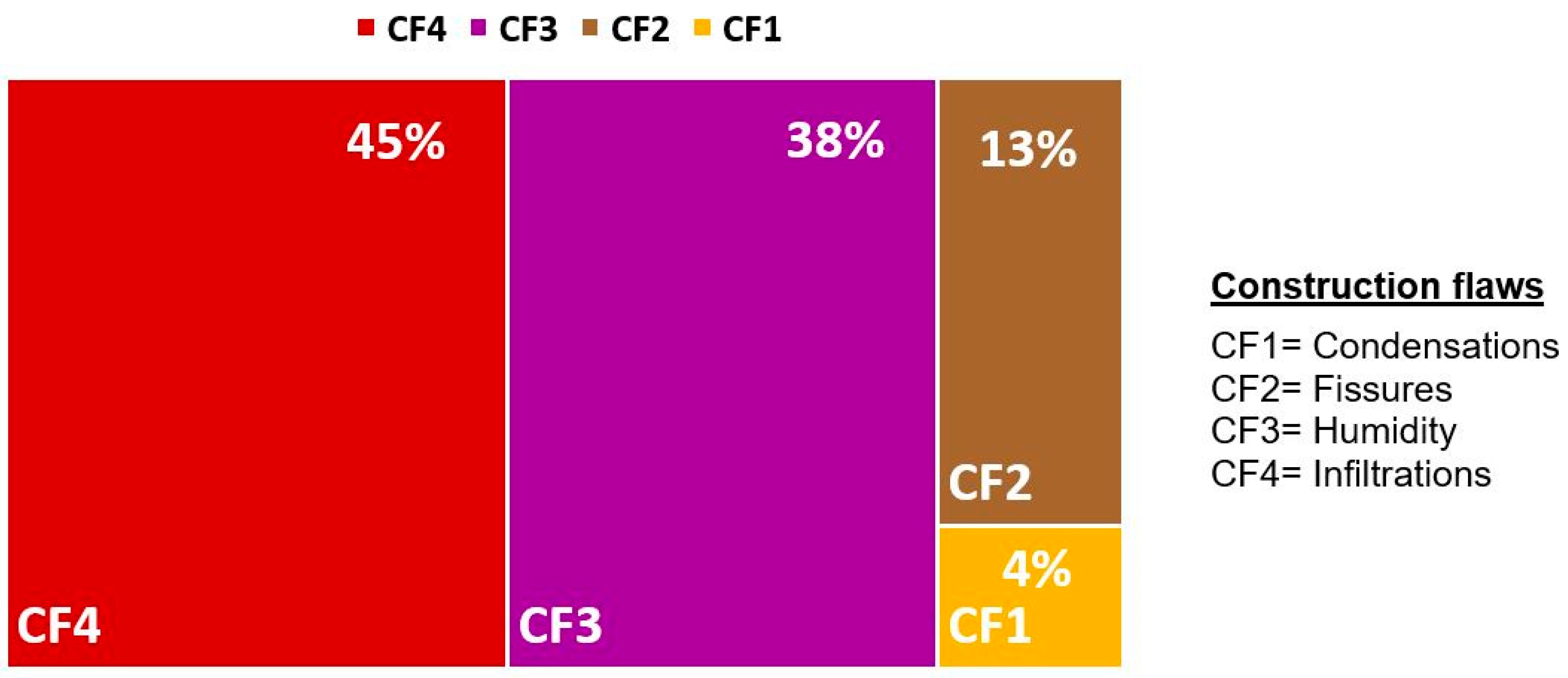
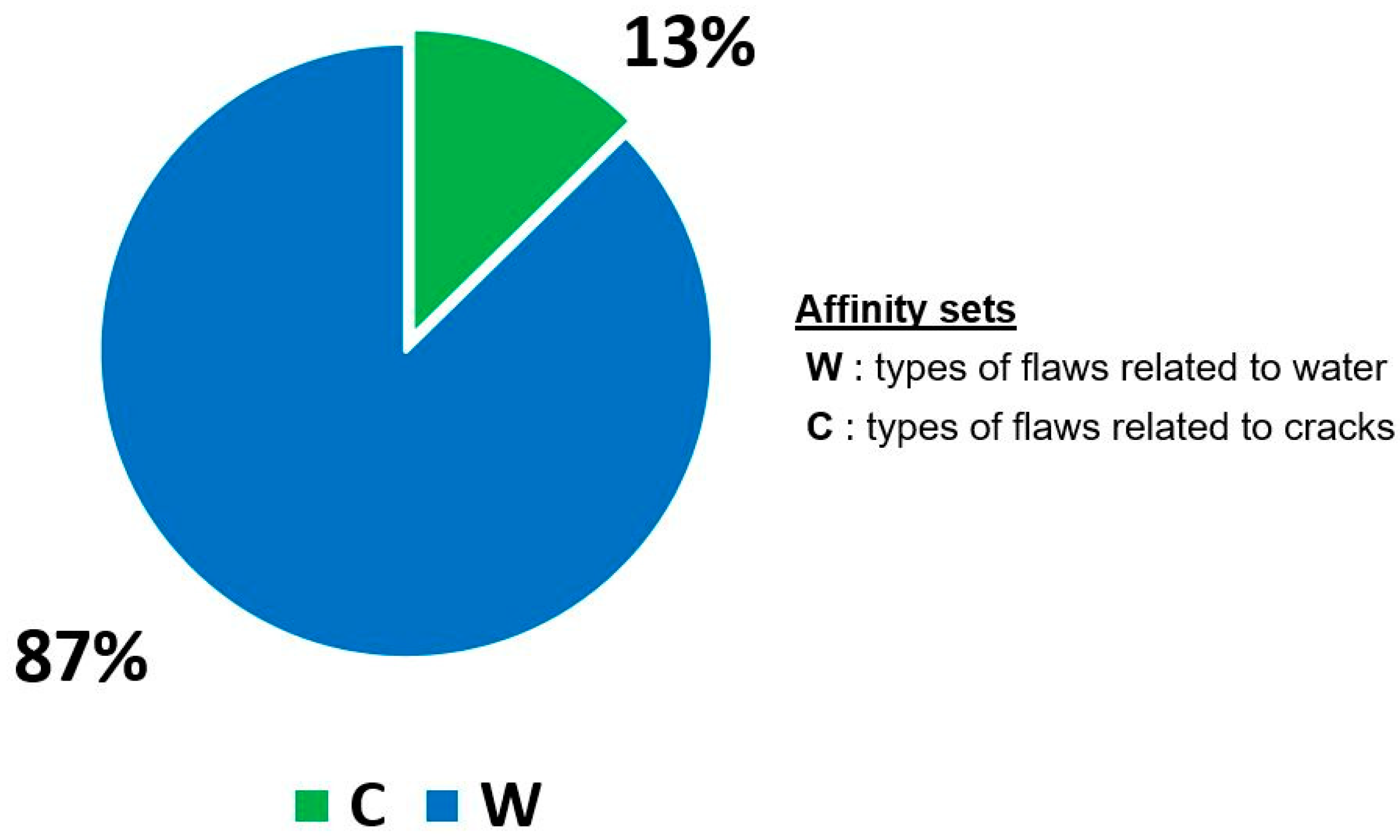
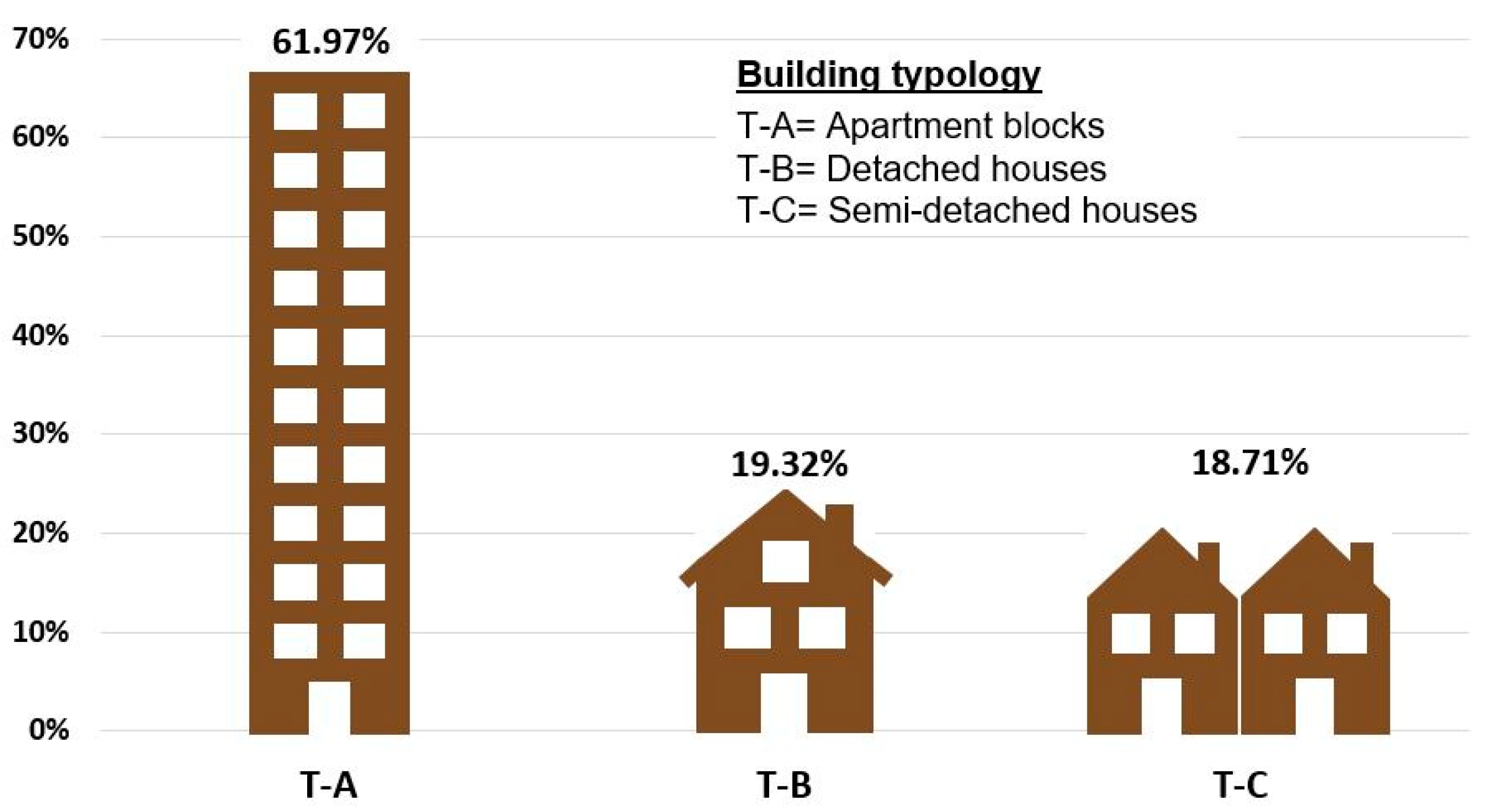
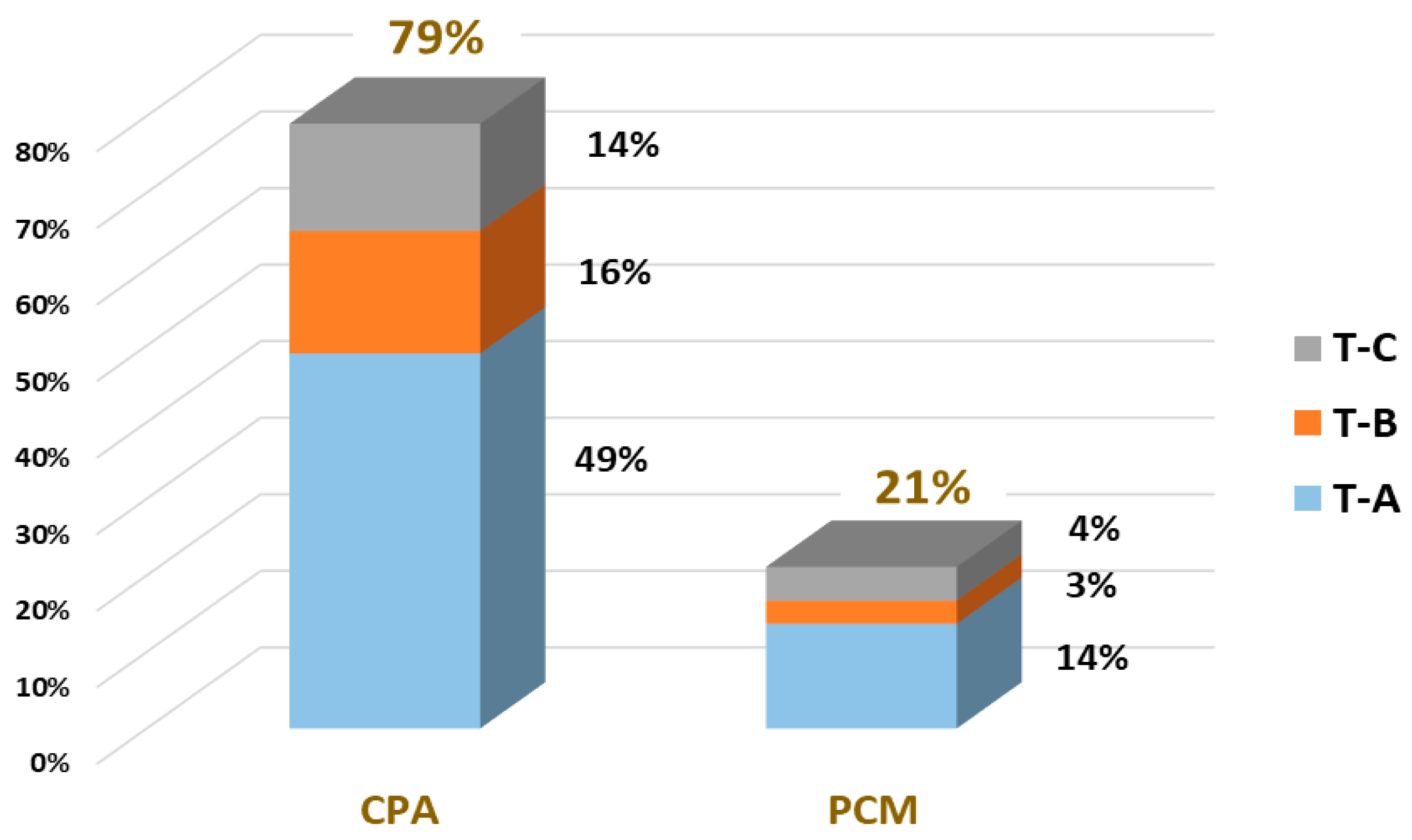
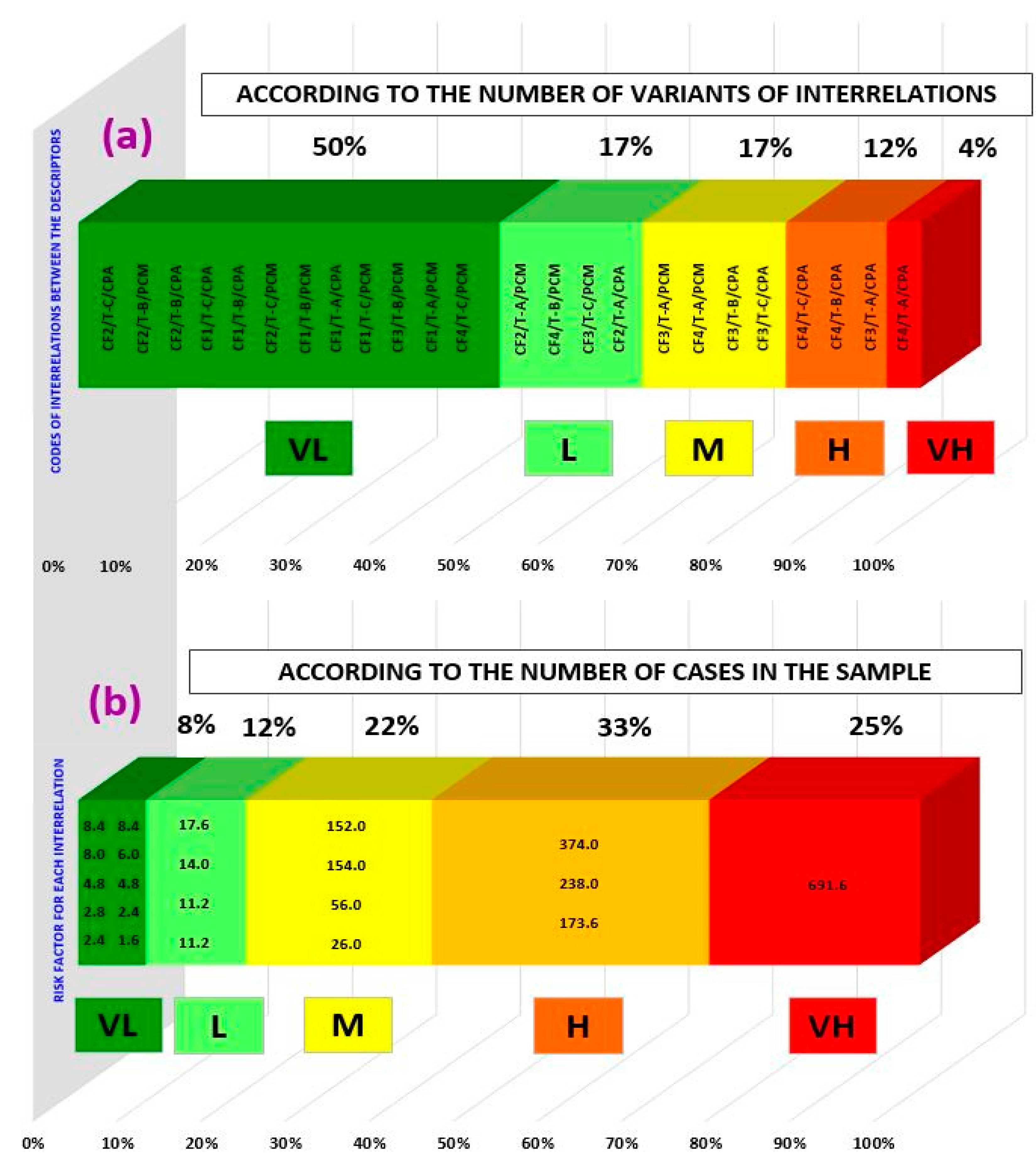
| Code | Concept | Classes | |||
|---|---|---|---|---|---|
| P | Population (number of inhabitants) | P1 | P2 | P3 | P4 |
| <500,000 | ≥500,000 and <1,000,000 | ≥1,000,000 and <3,000,000 | ≥3,000,000 | ||
| H | Number of houses | H1 | H2 | H3 | H4 |
| <200,000 | ≥200,000 and <400,000 | ≥400,000 and <1,000,000 | ≥1,000,000 | ||
| G | Gross domestic product per capita | G1 | G2 | G3 | G4 |
| <17,000 | ≥17,000 and <20,000 | ≥20,000 and <25,000 | ≥25,000 | ||
| COD.-T | Icon | CF1 | CF2 | CF3 | CF4 | ||||||||
|---|---|---|---|---|---|---|---|---|---|---|---|---|---|
| PCM | CPA | ST | PCM | CPA | ST | PCM | CPA | ST | PCM | CPA | ST | ||
| T-A |  | 35 | 10 | 45 | 44 | 35 | 79 | 7 | 49 | 55 | 9 | 55 | 64 |
| (1.4) | (0.4) | (1.8) | (5.6) | (4.4) | (10.1) | (2.6) | (18.7) | (21.3) | (4.0) | (24.7) | (28.8) | ||
| T-B |  | 20 | 5 | 25 | 5 | 3 | 8 | 2 | 19 | 21 | 2 | 19 | 21 |
| (0.8) | (0.2) | (1.0) | (0.6) | (0.4) | (1.0) | (0.8) | (7.2) | (8.0) | (0.8) | (8.5) | (9.3) | ||
| T-C |  | 25 | 5 | 30 | 11 | 2 | 13 | 4 | 20 | 24 | 1 | 14 | 15 |
| (1.0) | (0.2) | (1.2) | (1.4) | (0.2) | (1.6) | (1.4) | (7.6) | (9.1) | (0.6) | (6.2) | (6.8) | ||
| STAGE | CONCEPT | VALUES | |||||
|---|---|---|---|---|---|---|---|
| ‘Scoring’ according to the degree of the problem (STAGE 1) | Type of score | Value per descriptor | |||||
| Score according to nuisance to owners | CF1 | CF2 | CF3 | CF4 | |||
| 3 | 1 | 5 | 7 | ||||
| Score according to technical importance | PCM | CPA | |||||
| 2 | 4 | ||||||
| ‘Level of joint severity’ between construction flaw and pathology origin (STAGE 2) | Combined score for each interrelation | Type of construction flaw | |||||
| CF1 | CF2 | CF3 | CF4 | ||||
| Pathology origin | PCM | 6 | 2 | 10 | 14 | ||
| CPA | 12 | 4 | 20 | 28 | |||
| ‘Interrelation and intensity matrix’ between construction flaws, building typology and pathology origin (STAGE 3) | Presence of each interrelation (%) | Type of construction flaw | |||||
| CF1 | CF2 | CF3 | CF4 | ||||
| Building typology and pathology origin | T-A | PCM | 1.4 | 5.6 | 2.6 | 4.0 | |
| CPA | 0.4 | 4.4 | 18.7 | 24.7 | |||
| T-B | PCM | 0.8 | 0.6 | 0.8 | 0.8 | ||
| CPA | 0.2 | 0.4 | 7.2 | 8.5 | |||
| T-C | PCM | 1.0 | 1.4 | 1.4 | 0.6 | ||
| CPA | 0.2 | 0.2 | 7.6 | 6.2 | |||
| ‘Weighted risk matrix for lawsuits’ to determine the risk factor –F–(STAGE 4) | Presence of each interrelation | Type of construction flaw | |||||
| CF1 | CF2 | CF3 | CF4 | ||||
| Building typology and pathology origin | T-A | PCM | 8.4 | 11.2 | 26.0 | 56.0 | |
| CPA | 4.8 | 17.6 | 374.0 | 691.6 | |||
| T-B | PCM | 4.8 | 1.2 | 8.0 | 11.2 | ||
| CPA | 2.4 | 1.6 | 144.0 | 238.0 | |||
| T-C | PCM | 6.0 | 2.8 | 14.0 | 8.4 | ||
| CPA | 2.4 | 0.8 | 152.0 | 173.6 | |||
| ‘Risk categories’ of lawsuits by owners (STAGE 5) | Determination according to the value of risk factor | ||||||
| Category | Code | Condition | No. interrelations (Figure 5a) | No. cases (Figure 5b) | F = risk factor, according to Stage 4 | ||
| Very High | VH | F ≥ 400 | 1 interrelation | 123 cases | |||
| High | H | 170 ≤ F < 400 | 3 interrelations | 166 cases | |||
| Moderate | M | 25 ≤ F < 170 | 4 interrelations | 107 cases | |||
| Low | L | 10 ≤ F < 25 | 4 interrelations | 61 cases | |||
| Very Low | VL | F < 10 | 12 interrelations | 40 cases | |||
| Population (p) | % Popul. | Houses (h) | Houses | Gross Dom. Prod. Per Capita | % Gross Dom. Prod. Per Capita | Const. Flaw (cf) | % Cases |
|---|---|---|---|---|---|---|---|
| P1 | 13.06% | H1 | 11.86% | G1 | 2.01% | CF1 | 0.20% |
| CF2 | 0.20% | ||||||
| CF3 | 0.40% | ||||||
| CF4 | 1.21% | ||||||
| G2 | 3.62% | CF1 | 0.20% | ||||
| CF2 | 0.20% | ||||||
| CF3 | 1.41% | ||||||
| CF4 | 1.81% | ||||||
| G3 | 2.01% | CF2 | 0.20% | ||||
| CF3 | 1.01% | ||||||
| CF4 | 0.80% | ||||||
| G4 | 4.22% | CF1 | 0.40% | ||||
| CF3 | 1.41% | ||||||
| CF4 | 2.41% | ||||||
| H2 | 1.20% | G2 | 1.20% | CF3 | 0.40% | ||
| CF4 | 0.80% | ||||||
| P2 | 36.82% | H1 | 0.20% | G2 | 0.20% | CF4 | 0.20% |
| H2 | 36.62% | G1 | 6.03% | CF1 | 0.60% | ||
| CF2 | 1.21% | ||||||
| CF3 | 2.41% | ||||||
| CF4 | 1.81% | ||||||
| G2 | 12.88% | CF1 | 1.01% | ||||
| CF2 | 1.21% | ||||||
| CF3 | 5.63% | ||||||
| CF4 | 5.03% | ||||||
| G3 | 7.85% | CF1 | 0.60% | ||||
| CF2 | 1.81% | ||||||
| CF3 | 2.62% | ||||||
| CF4 | 2.82% | ||||||
| G4 | 9.86% | CF1 | 0.20% | ||||
| CF2 | 1.41% | ||||||
| CF3 | 5.23% | ||||||
| CF4 | 3.02% | ||||||
| P3 | 32.4% | H3 | 24.16% | G1 | 3.22% | CF1 | 0.20% |
| CF2 | 0.40% | ||||||
| CF3 | 1.21% | ||||||
| CF4 | 1.41% | ||||||
| G2 | 11.68% | CF1 | 0.20% | ||||
| CF2 | 1.81% | ||||||
| CF3 | 3.62% | ||||||
| CF4 | 6.05% | ||||||
| G3 | 6.24% | CF2 | 0.40% | ||||
| CF3 | 2.82% | ||||||
| CF4 | 3.02% | ||||||
| G4 | 3.02% | CF2 | 0.20% | ||||
| CF3 | 1.21% | ||||||
| CF4 | 1.61% | ||||||
| H4 | 8.25% | G3 | 8.25% | CF2 | 1.61% | ||
| CF3 | 3.22% | ||||||
| CF4 | 3.42% | ||||||
| P4 | 17.7% | H4 | 17.71% | G4 | 17.71% | CF1 | 0.40% |
| CF2 | 2.01% | ||||||
| CF3 | 5.84% | ||||||
| CF4 | 9.46% |
© 2019 by the authors. Licensee MDPI, Basel, Switzerland. This article is an open access article distributed under the terms and conditions of the Creative Commons Attribution (CC BY) license (http://creativecommons.org/licenses/by/4.0/).
Share and Cite
Carretero-Ayuso, M.J.; Rodríguez-Jiménez, C.E. Calculation of the Risk of Lawsuits over Construction Flaws in Flat Roofs. Sustainability 2019, 11, 5099. https://doi.org/10.3390/su11185099
Carretero-Ayuso MJ, Rodríguez-Jiménez CE. Calculation of the Risk of Lawsuits over Construction Flaws in Flat Roofs. Sustainability. 2019; 11(18):5099. https://doi.org/10.3390/su11185099
Chicago/Turabian StyleCarretero-Ayuso, Manuel J., and Carlos E. Rodríguez-Jiménez. 2019. "Calculation of the Risk of Lawsuits over Construction Flaws in Flat Roofs" Sustainability 11, no. 18: 5099. https://doi.org/10.3390/su11185099
APA StyleCarretero-Ayuso, M. J., & Rodríguez-Jiménez, C. E. (2019). Calculation of the Risk of Lawsuits over Construction Flaws in Flat Roofs. Sustainability, 11(18), 5099. https://doi.org/10.3390/su11185099






